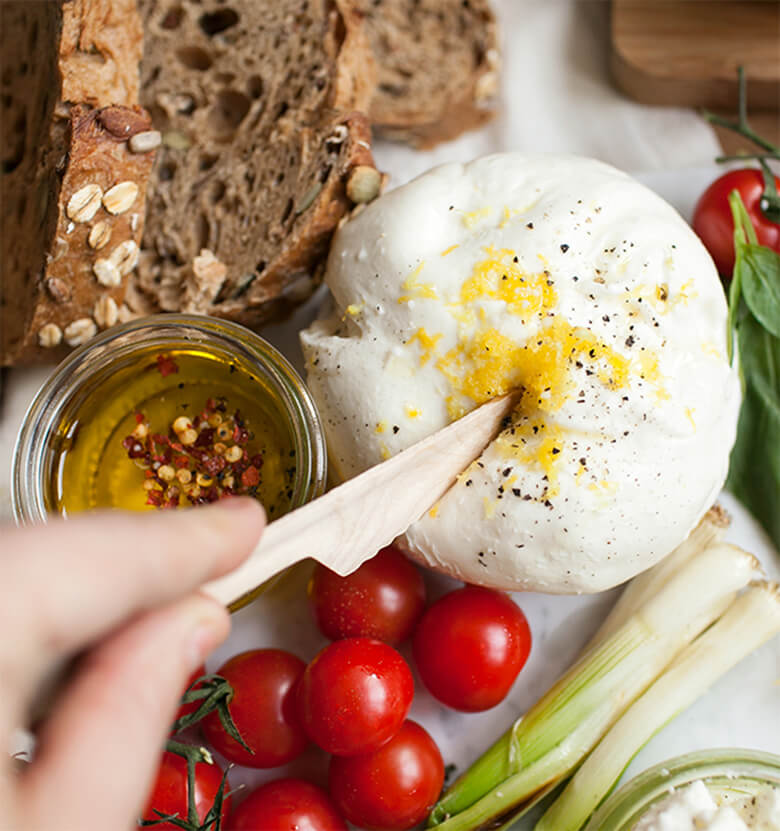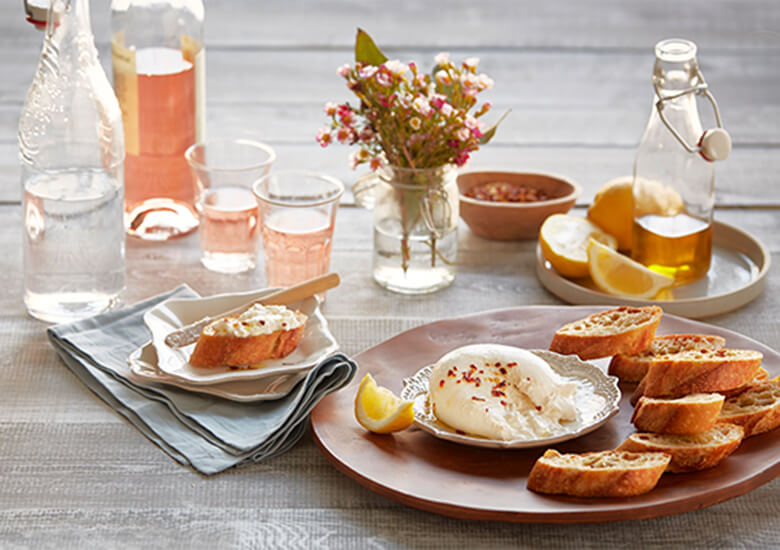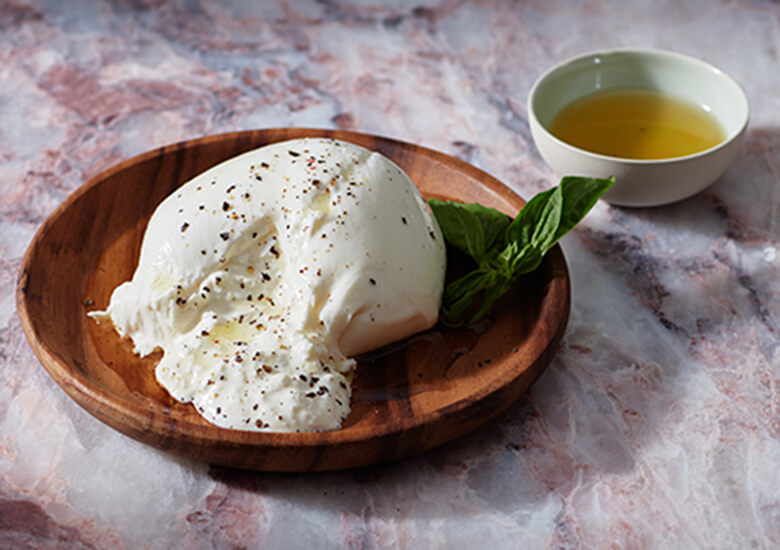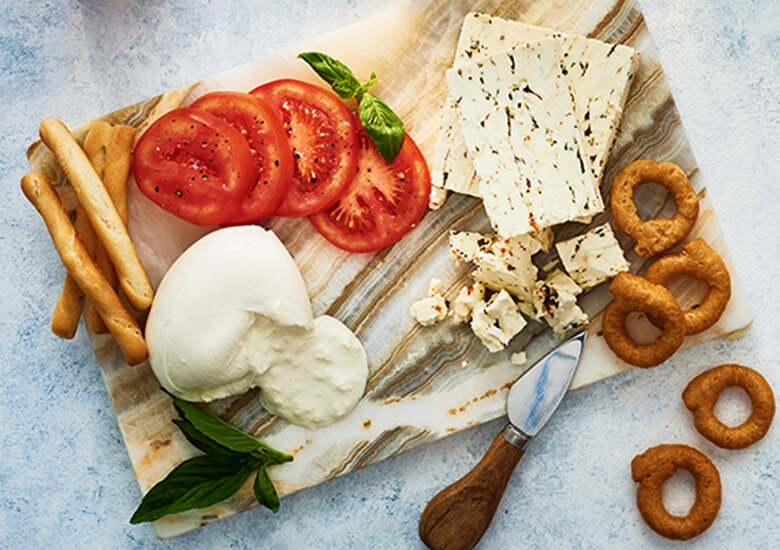If you ask us, every cheese is special, but we’d be hard-pressed
to name any quite like burrata. After all, what other cheese is filled with even
more cheese? If you’ve never had the rind-blowing experience of cutting
into a ball of burrata, you’re in for a special treat. Read on to learn all
about this one-of-a-kind cheese.
Cheese History: The story behind burrata

Burrata was first created in the 1920s in the
southern Italian region of Apulia. A small farm, known for its mozzarella, tried to find a way to repurpose unused scraps of mozzarella—and
just like that, burrata was born. Named for its resemblance to butter (burro in Italian), it became an instant classic and sought-after delicacy. However, importing such a fresh cheese from Italy proved to be a challenge. That's when Wisconsin Cheesemakers stepped in, crafting their own burrata with farm-fresh milk right in the heart of America's Dairyland.
All about burrata cheese
There is so much to discover about this delectable Italian cheese - from how burrata is made to how long it is aged - that we put together an overview for you to peruse while preparing to take your first bite.
How is burrata cheese made?
Burrata cheese starts life in a process that’s identical to mozzarella
before transforming into the soft, delicate pouch of dairy-filled deliciousness
we all know and love. The cheesemaking process for Wisconsin-made burrata
starts with fresh milk that is heated with a whey starter to which good
bacteria and rennet are added. This process creates curds,
which are warmed until they become soft and elastic.
That’s when cheesemakers
start the physically-taxing process of stretching, kneading, and molding
these 150-degree hot curds. During this stretching process, the curds are formed
into a pouch and filled with extra mozzarella and cream before being spun or
knit closed by hand.
Traditional burrata uses Stracciatella di bufala,
cheese, and cream in Italy, as filling. This stracciatella cheese filling is a
special kind of stretched curd, like a fancy Italian cheese curd. BelGioioso, a
favorite Wisconsin Cheesemaker, uses regular milk to make it more accessible.
Burrata is typically sold in tubs filled with water to maximize freshness while
it travels to you. Burrata cheese is truly a labor of love—and it pays off in
taste and texture!
What does burrata cheese taste like?

Burrata cheese is like a cheesy dumpling where the wrapper is
cheese and the filling is…also cheese. (Wet told you we take our cheese seriously in Wisconsin.) What could be better? Slicing into
burrata is like slicing into a perfectly runny egg. The outside is a delicate
mozzarella, and the inside is filled with even more mozzarella and cream. It’s a
delicate, rich, and creamy cheese that’s a sensory experience in and of itself.
Since burrata is a fresh
cheese,
it’s best enjoyed immediately after purchase.
What’s the difference between mozzarella and burrata?
At first glance, both of these cheeses can look quite similar—after
all, they’re both beautiful balls of white cheese. Burrata is made of mozzarella
cheese but formed into a pouch that is then filled with fresh cheese curds and
cream. Because of the additional cream, burrata
is richer and more flavorful than mozzarella. Both cheeses are exceptionally
fresh, milky, and perfect for warm summer days.
How long is burrata aged?
Burrata is not aged at all. Burrata is ready to be enjoyed the
very same day it’s made, and that’s what we’d recommend when possible. If you’re
getting it from the grocery store or local cheesemonger, have it ASAP. (Not
that any cheese lover could resist!)
Must-try Wisconsin Burrata

BelGioioso Burrata: BelGioioso’s
award-winning burrata is a textbook example of Wisconsin burrata: Italian
innovation mixed with Wisconsin dairy and passion for cheese. Expect a soft delicate
ball of burrata that, when cut into, splits open to reveal a luxurious creamy
filling that gently spills over your plate.
BelGioioso Black Truffle Burrata: Each
handcrafted pouch of burrata is seasoned with Black Summer Truffles, lending this delicate cheese an earthy, woodsy, slightly mushroomy taste that is utterly perfect. This is the ideal fresh cheese for an
expensive-tasting dinner at home.
Pairing and serving burrata cheese

What do you serve with burrata?
Burrata is delicious on just about anything. Drizzled with olive oil and sprinkled with salt and pepper, it’s delightful when served with crusty bread. You can also top salads or grilled vegetables with burrata. Its creamy filling means you don’t need any dressing.
What wine pairs best with burrata cheese?
We love sipping on a light white wine or rosé while enjoying burrata. Grab a bottle of sauvignon blanc or a pinot grigio—you won’t be disappointed. Unfortunately, the tannins in red wines can overwhelm burrata’s light flavor, so we suggest saving your favorite reds for other cheese pairings.
What accompaniments should I serve with burrata cheese?
Fresh seasonal produce makes a great match for burrata. You can never go wrong with veggies like just-picked heirloom tomatoes, roasted peppers, or even grilled zucchini. Serve everything alongside a lightly toasted baguette and your choice of olive oil.
Taste the freshness!
We know what you’re thinking: it’s time for a cheese
tasting full of Wisconsin’s finest cheeses. Have cheese delivered
right to your door with our continuously updated list of cheesemakers and
retailers that allow you to order
cheese online. Award-winning Wisconsin Cheese is just a click away.
Craving something else? Choose from our selection of over 400 recipes
featuring Wisconsin Cheese.
Don’t forget to share your creative cheesy creations with us on Facebook and Instagram!